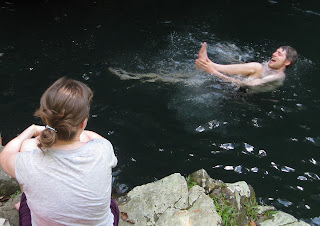Driving from the coast to the town of Jayuya in La Cordillera Central is not easy. Although the mountain roads of Puerto Rico are paved, most are extremely narrow and curvy.
On our drive from Playa Lucia, we arrived in Jayuya after dark, and tooled around the town looking for something to eat. Although the town has several restaurants, they were all closed. Open only on Thursday, Friday, and Saturday. We were forced to resort to the grocery store and a pizza kiosk on wheels.
But dinner was fun anyway. We made pina coladas and ate the tasty pizza on the balcony of our hotel, Posada Jayuya (hotel phone #: 787.828.7250; calls from the U.S. to Puerto Rico are not international calls).
La Piedra Escrita, an ancient Taino site
The next day, we went first to La Piedra Escrita on the outskirts of Jayuya. La Piedra Escrita is one of Puerto Rico’s most honored remainders of the indigenous Taino culture. It’s a boulder 32 ft high and 13 ft wide, in the middle of a river – Rio Saliente.
On the rock are 52 petroglyphs carved by indigenous groups between 600 and 1200 A.D. The boulder creates a natural pool in the river. Alan and Matt jumped off the boulder and swam.
Toro Negro State Forest
The next day we took off for a major hike in El Bosque Estatal de Toro Negro (Toro Negro State Forest ), one of the highest and most extensive forests on the island, in the Central Mountains (La Cordillera Central). We drove about an hour south of Jayuya to get there, along La Ruta Panamerica. When we arrived, we took a simple map from the ranger station but it wasn’t a lot of help.
The first part of the hike was fantastic – we walked along Quebrada Dona Juana (a mountain stream).
Finally, we realized we’d missed our turn onto Trail 9. And we seemed to be lost. Dismay began to set in. Having a fresh head cold, I was already exhausted.
The wildlife
We saw lots of birds: Black-throated Blue Warblers, Northern Parulas, Green Mangos, Cape May Warblers, Belted Kingfishers, and more. And several other interesting creatures along the way…like this lizard Alan photographed. Was it a dwarf gecko? Not sure.
Alan found a giant predatory centipede, Scolopendra. (Photo of Puerto Rican Scolopendra species by Alan Kneidel)
Would we ever get out?
Just after we decided we really were lost, we stumbled upon a paved road! We walked downhill on the road for about 5 miles, and found the spot where we’d left our car.
Our forest hike had been beautiful, if somewhat daunting.
Jayuya again
Back we went to Jayuya, once again to find no restaurants open. We ate pizza on the balcony of the hotel again, and then took a swim in the hotel pool, decorated with this mermaid, below.
Jayuya was a friendly place after all
Except for the restaurant factor, Jayuya was a friendly enough place. No one was rude or hostile except for a couple of older folks who had been around during the 1950 Jayuya Uprising against the U.S. Most folks were warm and helpful.
On to dry forest and mangroves ….Alan’s research home
The next morning we took off for our last stop – Alan’s hometown of Playa Santa in the dry forest, with its coastal mangroves – and what turned out to be the most beautiful beach of all.
My previous posts about this trip to Puerto Rico:
Old San Juan: steep, tropical, colorful
Exploring the tropical rainforest in Puerto Rico: El Yunque Caribbean National Forest
Puerto Rican beach pleasures, and the Jayuya Uprising
Alan’s blogs:
http://goodbykneidel.blogspot.com
http://beerandtrees.com
Helpful resource:
Suzanne Van Atten. Puerto Rico. Moon Handbooks. 2nd Edition, 2009.
Key words:
Puerto Rico Jayuya Toro Negro Ruta Panamerica Posada Jayuya Kneidel











